Influence of Seasonal Air–Sea Interaction on the Interannual Variation of the NPP of Terrestrial Natural Vegetation in China
Abstract
:1. Introduction
2. Materials and Methods
2.1. Data Sources
2.1.1. Remote Sensing Data
2.1.2. Climate Data
2.2. Analytical Method
2.2.1. NPP Estimation
2.2.2. Linear Trend
2.2.3. Coefficient of Variation
2.2.4. Coefficient of Association
2.2.5. Composite Analysis
3. Results
3.1. Spatial Distribution of Climatic Characteristics of Annual NPP
3.2. Key Climatic Area of Annual NPP Response to Climatic Factors
4. Climatic Factors Influence Annual NPP and Processes in the Key Climatic Area
4.1. Atmospheric Circulation Characteristics of Annual NPP Anomalies in the Key Climatic Area
4.2. Preceding SST Characteristics of Annual NPP Anomalies in the Key Climatic Area
4.3. The Processes of Sea–Air Interaction Affect the NPP of Natural Vegetation in the Key Area
5. Discussion
5.1. The Correlation between NPP and Climatic Factors in the Key Climatic Area
5.2. Stability and Sensitivity of Annual NPP Response to Climatic Factors
5.3. Uncertainty Analysis for the NPP of Natural Vegetation
5.4. Deficiencies of This Study
6. Conclusions
Author Contributions
Funding
Data Availability Statement
Conflicts of Interest
References
- Qin, D.H. Climate and environmental changes in China and their impacts and countermeasures. Theor. Dyn. 2006, 11, 28–38. [Google Scholar]
- National Assessment Report on Climate Change Committee. The Second National Assessment Report on Climate Change; Science Press: Beijing, China, 2011. [Google Scholar]
- Qin, D.H. The challenge of global climate change to Chinese sustainable development. China Dev. Obs. 2007, 4, 38–39. [Google Scholar] [CrossRef]
- Liu, D.S. Global changes and sustainability science. Earth Sci. Front. 2002, 9, 1–9. [Google Scholar] [CrossRef]
- IPCC. Climate Change 2022: Impacts, Adaptation, and Vulnerability; Cambridge University Press: Cambridge, UK, 2022. [Google Scholar]
- Zhou, T.J.; Chen, Z.M.; Chen, X.L.; Zuo, M.; Jiang, J.; Hu, S. Interpreting IPCC AR6: Future global climate based on projection under scenarios and on near-term information. Clim. Chang. Res. 2021, 17, 652–663. [Google Scholar] [CrossRef]
- Lin, H.L.; Zhao, J.; Liang, T.G.; Li, Z.Q. A Classification Indices-Based Model for Net Primary Productivity (NPP) and Potential Productivity of Vegetation in China. Int. J. Biomath. 2012, 5, 1260009. [Google Scholar] [CrossRef]
- Qing, H.J. The Reconstruction of Productivity in Mongolian Plateau Grassland from A.D. 1 to 2000 and Its Response to Climate Change. Ph.D. Thesis, Nanjing University of Information Science and Technology, Nanjing, China, 2018. [Google Scholar]
- Fang, J.Y. Global Ecology; Higher Education Press: Beijing, China, 2000; pp. 5–12. [Google Scholar]
- Zhu, W.Q. Estimation of Net Primary Productivity of Chinese Terrestrial Vegetation Based on Remote Sensing and Its Relationship with Global Climate Change. Ph.D. Thesis, Beijing Normal University, Beijing, China, 2005. [Google Scholar]
- Charney, J. Dynamics of deserts and drought in the Sahel. Q. J. R. Meteorol. Soc. 1975, 101, 193–202. [Google Scholar] [CrossRef]
- Alkama, R.; Cescatti, A. Biophysical impacts of climate change from recent changes in global forest cover. Science 2016, 351, 600–604. [Google Scholar] [CrossRef] [Green Version]
- Bonan, G.; Doney, S. Climate, ecosystems, and planetary futures: The challenge of predicting life in Earth system models. Science 2018, 359, eaam8328. [Google Scholar] [CrossRef] [Green Version]
- Huang, R.; Chen, J.; Huang, G. Characteristics and variations of the East Asian Monsoon System and its Impacts on Climate Disasters in China. Adv. Atmos. Sci. 2007, 24, 993–1023. [Google Scholar] [CrossRef]
- Luo, Q.; Zhou, J.; Li, Z.; Yu, B. Spatial differences of ecosystem services and their driving factors: A comparation analysis among three urban agglomerations in China’s Yangtze River Economic Belt. Sci. Total Environ. 2020, 725, 138452. [Google Scholar] [CrossRef]
- Morocho, M.C.; Fonseca, B.R.; Ramos, M.R. Sea surface temperature impacts on winter cropping systems in Iberian Peninsula. Agric. For. Meteorol. 2016, 227, 213–228. [Google Scholar] [CrossRef]
- Huang, R.H.; Chen, J.L.; Wang, L.; Lin, Z.D. Characteristics, processes, and causes of the spatio-temporal variabilities of the East Asian monsoon system. Adv. Atmos. Sci. 2012, 29, 910–942. [Google Scholar] [CrossRef]
- Huang, R.; Huang, G.; Wei, Z. Climate variations of the summer monsoon in China. In East Asian Monsoon; World Scientific Publishing Co. Pte. Ltd.: Singapore, 2004; pp. 213–270. [Google Scholar]
- Fu, C.B.; Wen, G.; Xie, L.; Zhao, M.S.; Yuan, H.L. The Diagnosis and Simulation Studies on Climate and Ecosystem Interactions in East Asia Monsoon Region. J. Nanjing Univ. 2002, 38, 281–294. [Google Scholar] [CrossRef]
- Li, C.H.; Zhou, M.; Wang, Y.T.; Zhu, T.B.; Sun, H.; Yin, H.H.; Cao, H.J.; Han, H.Y. Inter-annual variation of vegetation net primary productivity and the contribution of spatial-temporal and climate factors in arid northwest China: A case study of the Hexi Corridor. Chin. J. Ecol. 2020, 39, 3265–3275. [Google Scholar] [CrossRef]
- Zhang, R.P.; Guo, J.; Zhang, Y.L. Spatial distribution pattern of NPP of Xinjiang grassland and its response to climatic changes. Acta Ecol. Sin. 2020, 40, 5318–5326. [Google Scholar] [CrossRef]
- Tao, B.; Li, K.R.; Shao, X.M.; Cao, M.K. Temporal and spatial pattern of Net primary production of terrestrial ecosystems in China. Acta Geogr. Sin. 2003, 58, 372–380. [Google Scholar]
- Taboada, F.G.; Barton, A.D.; Stock, C.A.; Dunne, J.; John, J.G. Seasonal to interannual predictability of oceanic net primary production inferred from satellite observations. Prog. Oceanogr. 2019, 170, 28–39. [Google Scholar] [CrossRef]
- Cui, L.L.; Du, H.Q.; Shi, J.; Chen, Z.; Guo, W. Spatial and Temporal Pattern of Vegetation NPP and Iis Relationship with Climate in Southeastern China. Sci. Geogr. Sin. 2016, 36, 787–793. [Google Scholar] [CrossRef]
- Michaletz, S.T.; Cheng, D.; Kerkhoff, A.J.; Enquist, B.J. Convergence of terrestrial plant production across global climate gradients. Nature 2014, 512, 39–43. [Google Scholar] [CrossRef]
- Chen, X.L.; Zeng, Y.N. Spatial and temporal variability of net primary production (NPP) and its relationship with climate factors in subtropical mountainous and hilly regions of China: A case study in Hunan province. Acta Geogr. Sin. 2016, 71, 35–48. [Google Scholar] [CrossRef]
- Jia, J.H.; Liu, H.Y.; Lin, Z.S.S. Multitime scale changes in the vegetation NPP in six provinces of northwest China and their responses to climate change. Acta Ecol. Sin. 2019, 39, 5058–5069. [Google Scholar] [CrossRef]
- Potter, C.S.; Randerson, J.T.; Field, C.B.; Matson, P.A.; Vitousek, P.M.; Moony, H.A.; Klooster, S.A. Terrestrial ecosystem production: A process model based on global satellite and surface data. Glob. Biogeochem. Cycles 1993, 7, 811–841. [Google Scholar] [CrossRef]
- Reynolds, R.W.; Rayner, N.A.; Smith, T.M.; Stokes, D.C.; Wang, W.Q. An improved in situ and satellite SST analysis for climate. J. Clim. 2002, 15, 1609–1625. [Google Scholar] [CrossRef]
- Kalnay, E.; Kanamitsu, M.; Kistler, R.; Collins, W.; Deaven, D.; Gandin, L.; Iredell, M.; Saha, S.; White, G.; Woollen, J.; et al. The NCEP/NCAR 40-Year Reanalysis Project. Bull. Am. Meteorol. Soc. 1996, 77, 437–472. [Google Scholar] [CrossRef]
- Liangxia, Z.; Decheng, Z.; Jiangwen, F. Comparison of four light-use efficiency models for estimating terrestrial gross primary production. Ecol. Model. 2005, 300, 30–39. [Google Scholar] [CrossRef] [Green Version]
- Xiao, F.; Liu, Q.; Xu, Y. Estimation of Terrestrial Net Primary Productivity in the Yellow River Basin of China Using Light Use Efficiency Model. Sustainability 2022, 14, 7399. [Google Scholar] [CrossRef]
- Serbin, S.P.; Ahl, D.E.; Gower, S.T. Spatial and temporal validation of the MODIS LAI and FPAR products across a boreal forest wildfire chronosequence. Remote Sen. Environ. 2013, 133, 71–84. [Google Scholar] [CrossRef]
- Zhang, Y.; Lu, X.; Liu, B.; Wue, D.; Fu, G.; Zhao, Y.; Sun, P. Spatial relationships between ecosystem services and socioecological drivers across a large-scale region: A case study in the Yellow River Basin. Sci. Total Environ. 2021, 766, 142480. [Google Scholar] [CrossRef]
- Yan, H.M.; Li, C.Y.; Zhou, W. Influence of subtropical dipole pattern in southern Indian Ocean on ENSO event. Chin. J. Geophys. 2009, 52, 2436–2449. [Google Scholar] [CrossRef]
- Wei, F.Y. Modern Climate Statistical Diagnosis and Prediction Technology, 3rd ed.; Meteorological Press: Beijing, China, 2009; pp. 36–56. [Google Scholar]
- Zhi, H.; Wang, P.X.; Dan, L.; Yu, Y.Q.; Xu, Y.F.; Zheng, W.P. Climate-vegetation interannual variability in a coupled atmosphere-ocean-land model. Adv. Atmos. Sci. 2009, 26, 599–612. [Google Scholar] [CrossRef]
- Yu, Z.S.; Sun, Z.B.; Zeng, G. The effects of pacific SSTA on summer precipitation over eastern china I-Observational Analysis. J. Trop. Meteorol. 2005, 5, 467–477. [Google Scholar] [CrossRef]
- Qi, L.Y.; Sun, Z.B.; Li, Z.X. Winter Subsurface Layer Thermal State Character of the North Pacific and Its Relationship with the Summer Climate in the East of China. J. Nanjing Inst. Meteorol. 2007, 30, 153–161. [Google Scholar] [CrossRef]
- Li, Z.X.; Sun, Z.B. Numerical Simulations on the Influence of the Previous Winter Kuroshio SSTA on East Asian Summer Monsoon. J. Nanjing Inst. Meteorol. 2006, 29, 62–67. [Google Scholar] [CrossRef]
- Gao, H.; Gao, J. Increased influence of SST along the Kuroshio in the previous winter on summer precipitation in northeastern China. Acta Oceanogr. Sin. 2014, 36, 27–33. [Google Scholar] [CrossRef]
- Fang, Y.H.; Zhao, C.Y.; Li, Y.; Guo, T.T.; Li, J.W.; Lin, Y.T.; Qin, M.O.; Yu, Y.Q. A review of climatological research of cold vortex in Northeast China. J. Meteorol. Environ. 2022, 38, 92–99. [Google Scholar] [CrossRef]
- Milesi, C.; Elvidge, C.D.; Nemani, R.R.; Running, S.W. Assessing the impact of urban land development on net primary productivity in the southeastern United States. Remote Sens. Environ. 2003, 86, 401–410. [Google Scholar] [CrossRef]
- Li, H.I.; Wu, Y.P.; Liu, S.G.; Xiao, J.C. Regional contributions to the interannual variability of net primary production and climatic attributions. Agric. For. Meteorol. 2021, 303, 108384. [Google Scholar] [CrossRef]
- Wei, X.D.; Yang, J.; Luo, P.P.; Lin, L.G.; Lin, K.L.; Guan, J.M. Assessment of the variation and influencing factors of vegetation NPP and carbon sink capacity under different natural conditions. Ecol. Indic. 2022, 138, 108834. [Google Scholar] [CrossRef]
- Dan, L.; Ji, J.J. The surface energy, water, carbon flux and their intercorrelated seasonality in a global climate-vegetation coupled model. Tellus 2007, 59, 425–438. [Google Scholar] [CrossRef]
- Wu, S.H.; Zhou, S.L.; Chen, D.X.; Wei, Z.Q.; Dai, L.; Li, X.G. Determining the contributions of urbanization and climate change to NPP variation over the last decade in the Yangtza River Delta, China. Sci. Total Environ. 2014, 427, 397–406. [Google Scholar] [CrossRef]
- Wu, Y.Y.; Wu, Z.F.; Yu, S.X. Quantitative assessment of the impacts of human activities 601 on net primary productivity. Chin. Appl. Ecol. 2017, 28, 2535–2544. [Google Scholar] [CrossRef]
- Cui, L.L.; Shi, J.; Xiao, F.J. Impacts of climatic factors and El ño/La Niña events on the changes of terrestrial ecosystem NPP in China. Acta Geogr. Sin. 2018, 1, 54–66. [Google Scholar] [CrossRef]
- Buyantuyev, A.; Wu, J. Urbanization diversifies the phenology of the land surface in arid environments: Interactions between vegetation, climatic variation, and the pattern of land use in the Phoenix metropolitan region, USA. Landsc. Urban Plan. 2012, 105, 149–159. [Google Scholar] [CrossRef]
- Fang, J.Y.; Piao, S.L.; Field, C.B.; Pan, Y.D.; Guo, Q.H.; Zhou, L.M.; Peng, C.H.; Tao, S. Increasing net primary production in China from 1982 to 1999. Front. Ecol. Environ. 2003, 1, 293–297. [Google Scholar] [CrossRef]
- Tian, G.G.; Qiao, Z. Assessing the impact of the urbanization process on net primary 587 productivity in China in 1989–2000. Environ. Pollut. 2014, 184, 320–326. [Google Scholar] [CrossRef]
- Li, H.; Zhang, H.; Li, Q.; Zhao, J.; Guo, X.; Ying, H.; Deng, G.; Rihan, W.; Wang, S. Vegetation Productivity Dynamics in Response to Climate Change and Human Activities under Different Topography and Land Cover in Northeast China. Remote Sens. 2021, 13, 975. [Google Scholar] [CrossRef]
- Zhao, Z.Y.; Lin, Z.D.; Li, F.; Roges, B.M. Influence of atmospheric teleconnection on interannual variability of arctic-boreal fires. Sci. Total Environ. 2022, 838, 156550. [Google Scholar] [CrossRef]
- Goodrich, G. Atmospheric Teleconnections. Oxford Bibliographies in Geography. 2016. Available online: https://www.oxfordbibliographies.com/view/document/obo-9780199874002/obo-9780199874002-0147.xml (accessed on 20 October 2022).
- Dong, X.; Li, F.; Lin, Z.D.; Harrison, S.P.; Chen, Y.; Kug, J.S. Climate influence on the 2019 fires in Amazonia. Sci. Total Environ. 2021, 794, 148718. [Google Scholar] [CrossRef]
- Fang, J.Y.; Tang, Y.H.; Son, Y. Why are East Asian ecosystems important for carbon cycle research? Sci. China Life Sci. 2010, 53, 753–756. [Google Scholar] [CrossRef]

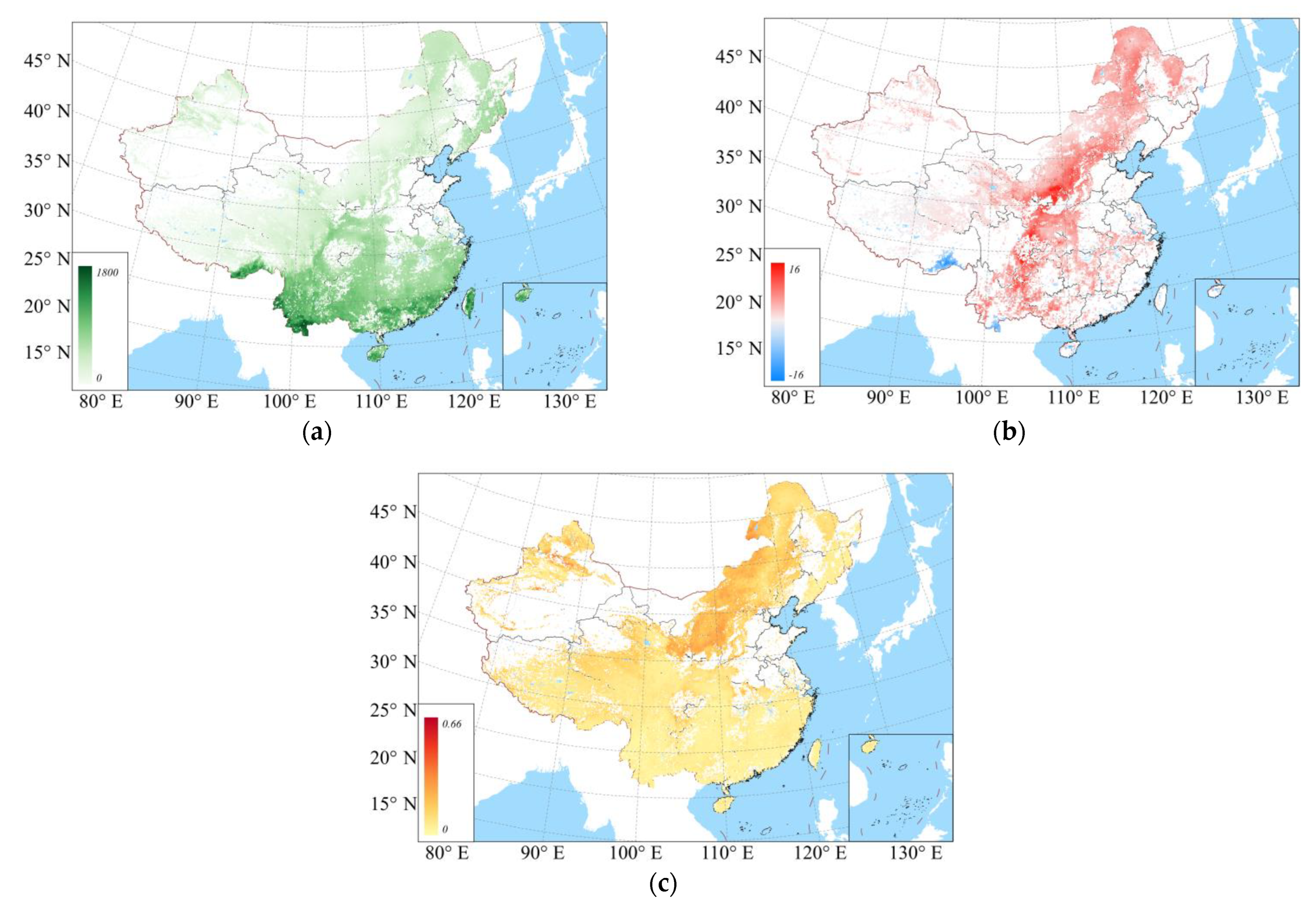
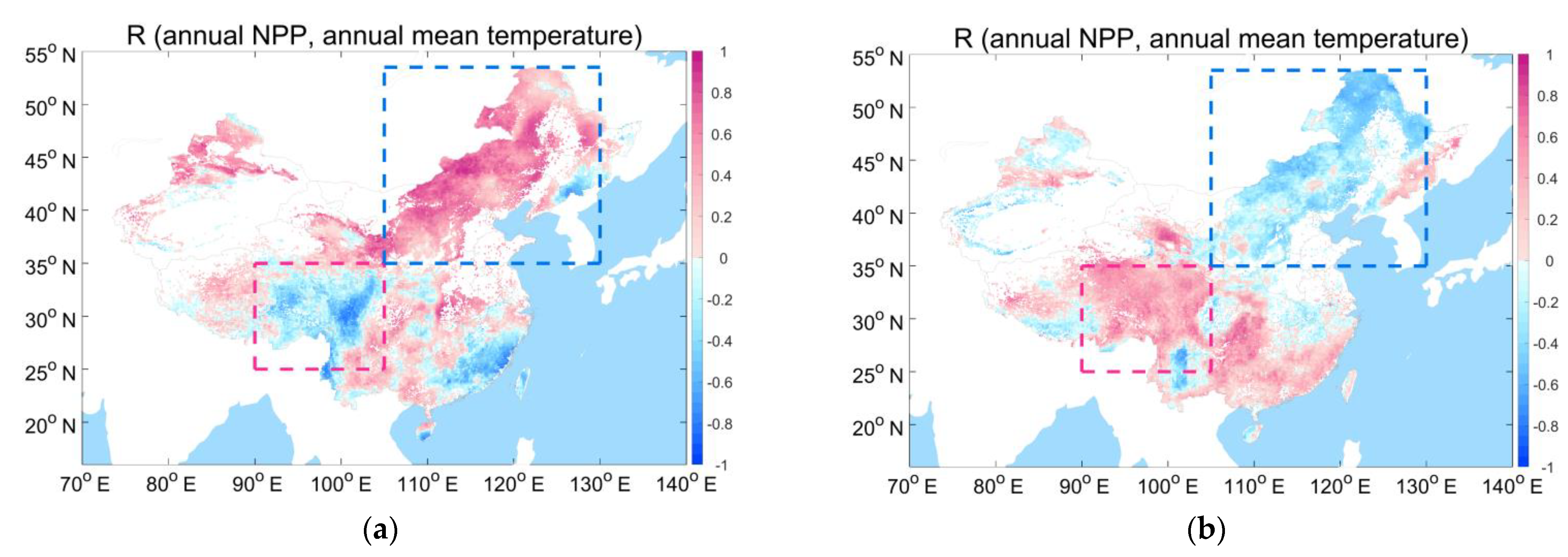
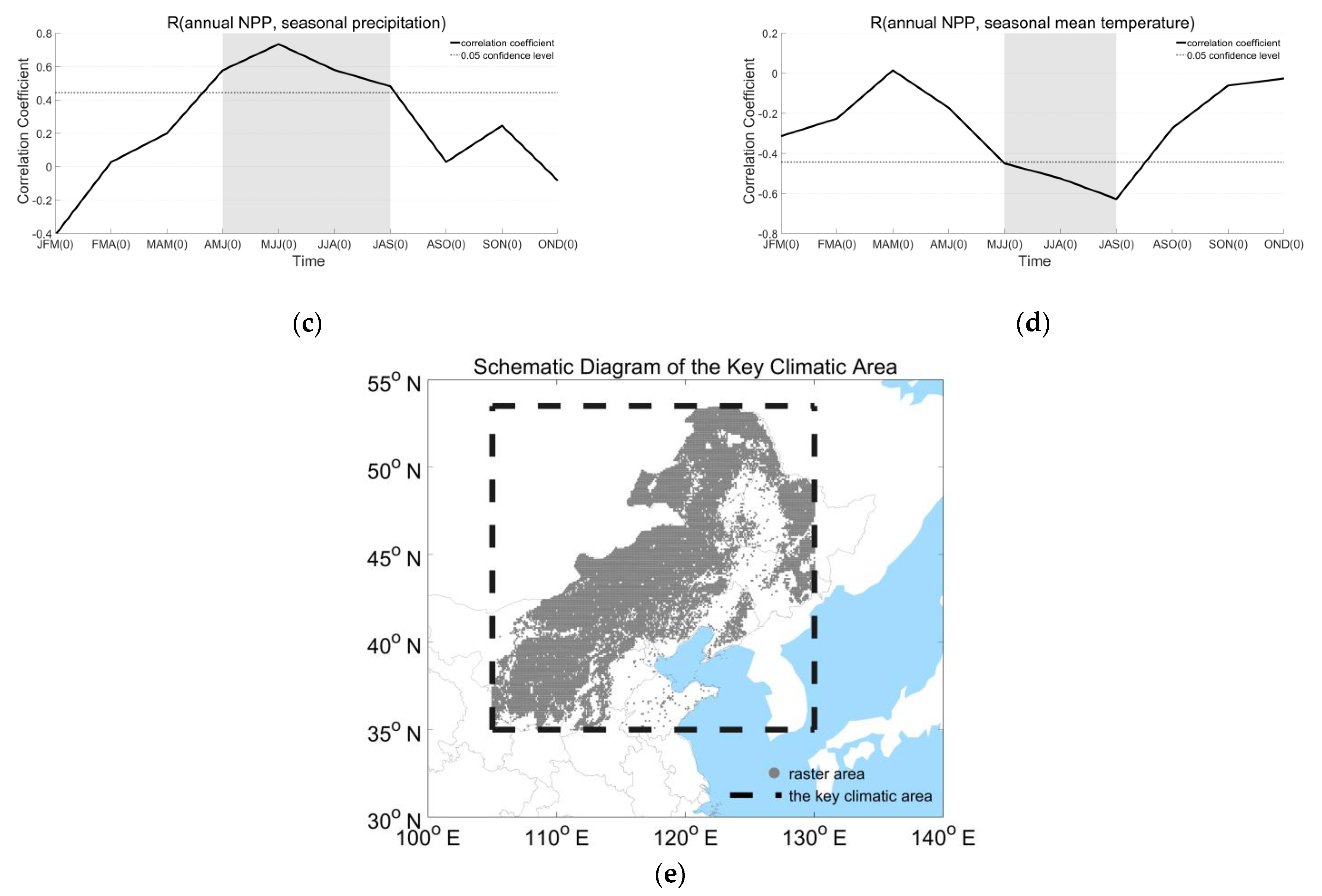
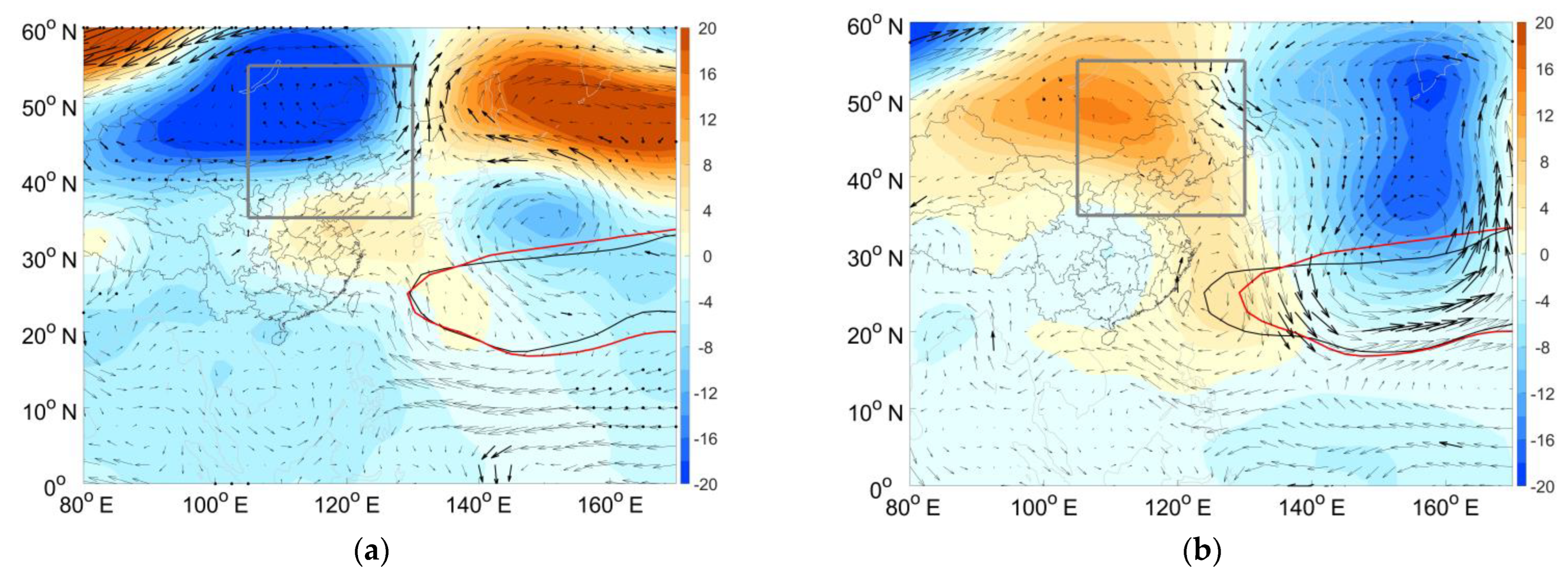
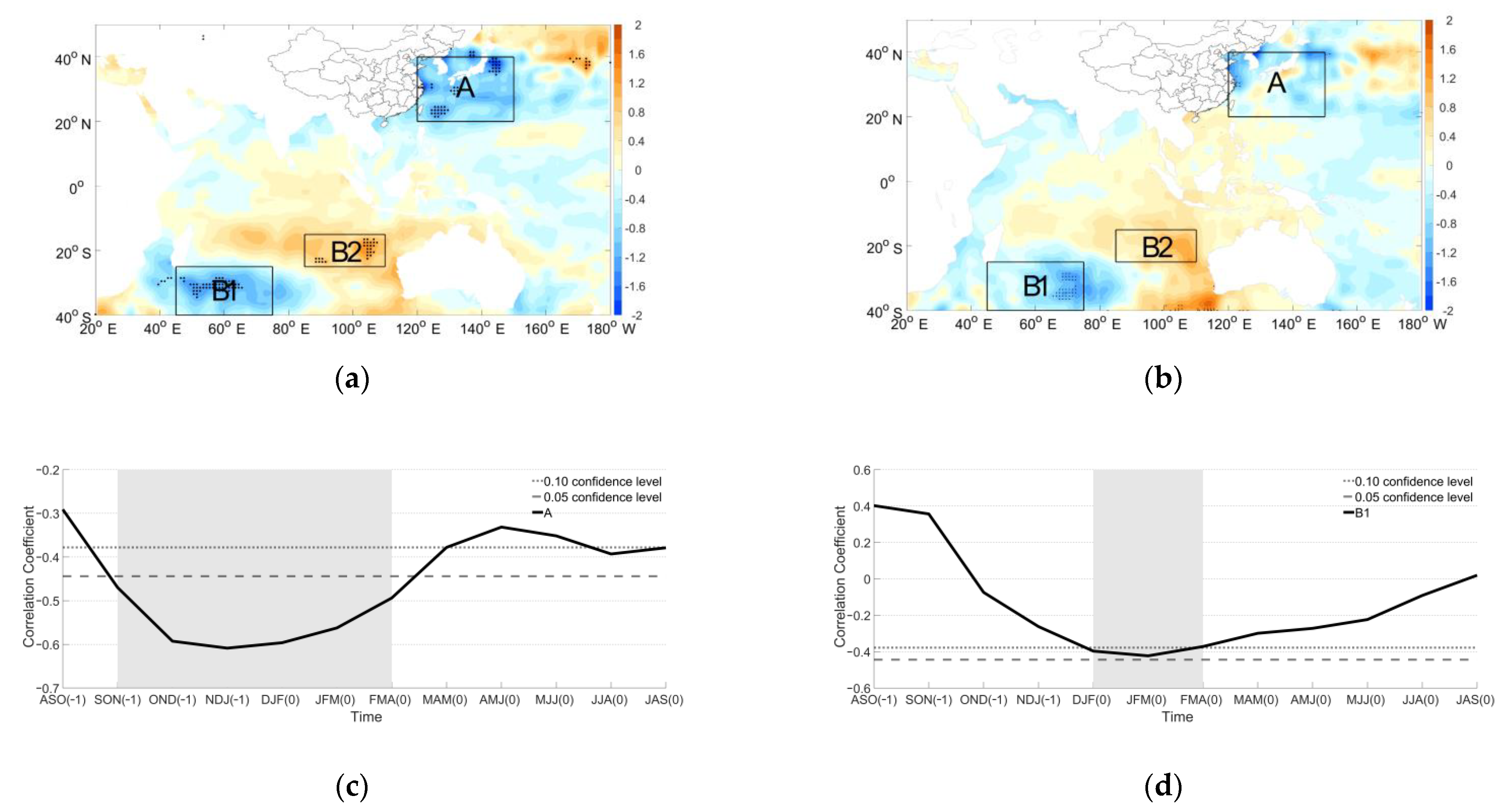
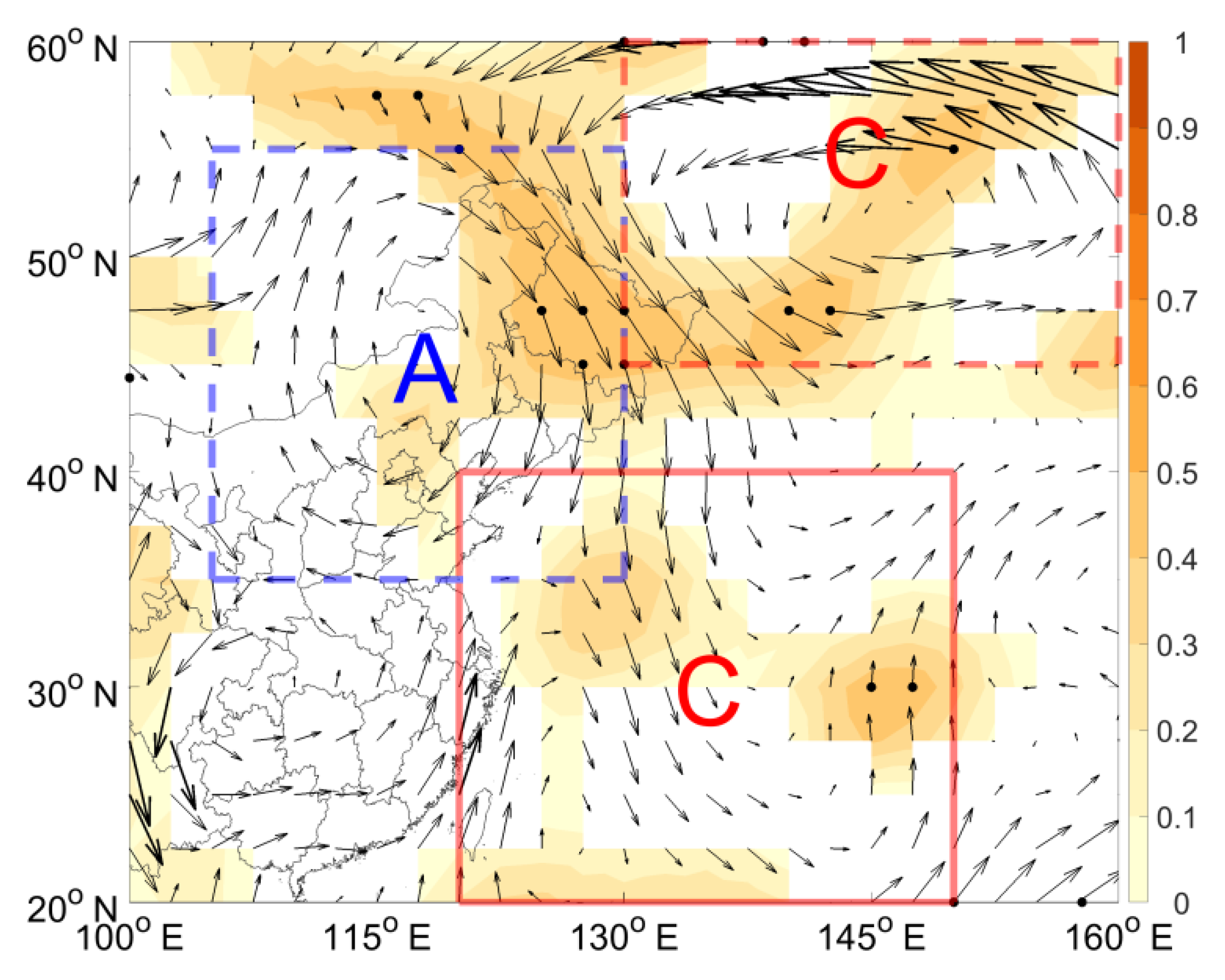


| Data ID | Data Source | Spatial Resolution | Temporal Resolution | Years | Unit |
|---|---|---|---|---|---|
| Temp | China Meteorological Administration | 0.1° × 0.1° | daily | 2001–2020 | °C |
| Prec | China Meteorological Administration | 0.1° × 0.1° | daily | 2001–2020 | mm |
| SST | https://psl.noaa.gov/data/gridded/data.noaa.oisst.v2.html, accessed on 1 March 2022. | 1.0° × 1.0° | monthly | 2000–2020 | °C |
| Uwnd | https://psl.noaa.gov/data/gridded/data.ncep.reanalysis.html, accessed on 1 March 2022. | 2.5° × 2.5° | monthly | 2001–2020 | m·s−1 |
| Vwnd | https://psl.noaa.gov/data/gridded/data.ncep.reanalysis.html, accessed on 1 March 2022. | 2.5° × 2.5° | monthly | 2001–2020 | m·s−1 |
| Omega | https://psl.noaa.gov/data/gridded/data.ncep.reanalysis.html, accessed on 1 March 2022. | 2.5° × 2.5° | monthly | 2001–2020 | Pa·s−1 |
| HGT | https://psl.noaa.gov/data/gridded/data.ncep.reanalysis.html, accessed on 1 March 2022. | 2.5° × 2.5° | monthly | 2001–2020 | gpm |
| Type | Correlation Coefficient | Median Correlation Coefficient | ||
|---|---|---|---|---|
| NPP & Precipitation | NPP & Temperature | NPP & Precipitation | NPP & Temperature | |
| Evergreen needleleaf forests | 0.543 * | −0.652 * | 0.586 * | −0.642 * |
| Deciduous needleleaf forests | 0.490 * | −0.550 * | 0.469 * | −0.523 * |
| Deciduous broadleaf forests | 0.465 * | −0.507 * | 0.324 | −0.435 |
| Mixed forests | 0.530 * | −0.434 | 0.407 | −0.421 |
| Closed shrublands | 0.506 * | −0.579 * | 0.439 | −0.530 * |
| Open shrublands | 0.711 * | −0.304 | 0.752 * | −0.294 |
| Woody savannas | 0.445 * | −0.407 | 0.372 | −0.382 |
| Savannas | 0.383 | −0.369 | 0.316 | −0.382 |
| Grasslands | 0.689 * | −0.627 * | 0.594 * | −0.550 * |
| Permanent wetlands | 0.389 | −0.555 * | 0.468 * | −0.531 * |
| Key climatic area | 0.639 * | −0.532 * | 0.525 * | −0.509 * |
Publisher’s Note: MDPI stays neutral with regard to jurisdictional claims in published maps and institutional affiliations. |
© 2022 by the authors. Licensee MDPI, Basel, Switzerland. This article is an open access article distributed under the terms and conditions of the Creative Commons Attribution (CC BY) license (https://creativecommons.org/licenses/by/4.0/).
Share and Cite
Bai, H.; Xiao, F.; Zhang, G.; Liu, Q.; Qin, Y.; Liao, Y. Influence of Seasonal Air–Sea Interaction on the Interannual Variation of the NPP of Terrestrial Natural Vegetation in China. Atmosphere 2022, 13, 1837. https://doi.org/10.3390/atmos13111837
Bai H, Xiao F, Zhang G, Liu Q, Qin Y, Liao Y. Influence of Seasonal Air–Sea Interaction on the Interannual Variation of the NPP of Terrestrial Natural Vegetation in China. Atmosphere. 2022; 13(11):1837. https://doi.org/10.3390/atmos13111837
Chicago/Turabian StyleBai, Hui, Fengjin Xiao, Guo Zhang, Qiufeng Liu, Yun Qin, and Yaoming Liao. 2022. "Influence of Seasonal Air–Sea Interaction on the Interannual Variation of the NPP of Terrestrial Natural Vegetation in China" Atmosphere 13, no. 11: 1837. https://doi.org/10.3390/atmos13111837






